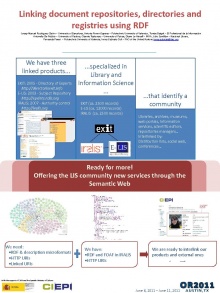
Linking document repositories, directories and registries using RDF
Rodríguez-Gairín, Josep-Manuel and Ferrer-Sapena, Antonia and Baiget, Tomàs and De Robbio, Antonella and Tsakonas, Giannis and Le Hénaff, Diane and Santillán, Julio and Peset, Fernanda and Subirats-Coll, Imma Linking document repositories, directories and registries using RDF., 2011 . In Sixth Annual International Conference on Open Repositories (OR11), Austin (US), 6-11 June 2011. [Conference poster]
In the development and management of document repositories it is crucial to maximize the standardization of certain group of fields in order to retrieve the documents located in the repository more efficiently. Historically the standardization focused primarily on subject headings, classifications or journal titles. The standardization of personal names has been also partially addressed, yet it is usually limited to provide a list of the existing author names present in the own system to select one of them before entering it manually. It has been in the recent years that information management specialists have realized that the maintenance of such authority files in self-archiving information systems, such as document repositories, should be performed by the creator of the record, the person who submits the documents.
During the last five years the International Centre for Research in Information Strategy and Development (CIEPI) has undertaken various services that aim to contribute in the standardization of personal names and to improve the interoperability among different information systems, like registries and document repositories, based on recognised standards.
In light of above, this poster presents the latest CIEPI’s developments based on the interoperability of E-LIS (E-prints in Library and Information Science), IraLIS (International Registry of Authors-Links to Identify Scientists), and EXIT (Directory of Experts in Information Handling).
The IraLIS project was initiated to address the problem of name disambiguation in Spanish-speaking countries, where the largest number of such cases appears due to the length of the signatures, the structure of names and so on. Similar problems of author identification appear in all languages, even in the Anglo-Saxon countries, due to the variant forms of name entries. Any person who studies and/or works in any aspect of science may register in IraLIS and create a record, regardless if has already published works, or plans to do so in the future. One of the principles that IraLIS promotes is that the sooner one adopts an IraLIS signature, the fewer problems regarding the retrieval of the works of an author will be encountered in the future.
When an external application is asking IraLIS for a specific person using an HTTP request, IraLIS answers with a RDF/XML file (Figure 1). The data obtained can then be integrated into the client application. Other examples of use of this service is the EXIT directory, which provides referrals to E-LIS repository, such as the number of the documents deposited by that person, or the XML returned by IraLIS displayed on the CIEPI website.
Another example regards the collaboration between IraLIS and E-LIS, which formally began in 2008. During the document upload procedure, when a user is typing the authors’ names, a dropdown menu suggests authorized names from the IraLIS registry. IraLIS answers the query made in OpenURL. The menu is updated automatically every night to collect the new IraLISed names. Users on E-LIS do not require to register in IraLIS before depositing documents, but it is highly advisable to standardize the signature and thus to facilitate the retrieval of all documents associated with a person.
One of the main pillars for the scientific information retrieval are author’s names. The problem of the inconsistencies in the authors’ signatures has been around for many years, but its importance is increasing due to the great number of people publishing research studies and papers and the self-archiving practices in many document repositories. For this reason, standardization is now a highly relevant aspect, more than ever. This poster aims to show the existing solution described above that day by day is becoming more accepted and used by the Library and Information Science Community.
